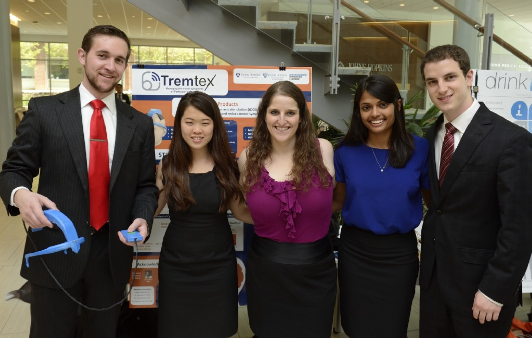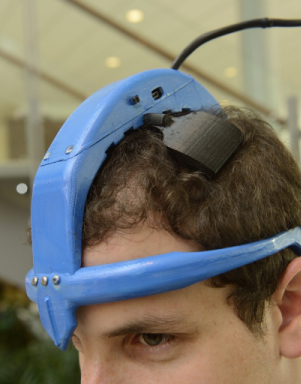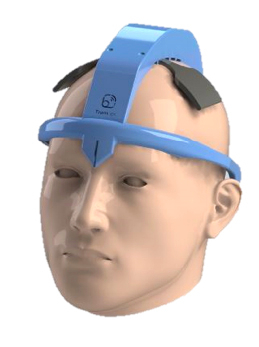Johns Hopkins Student Developed Noninvasive Brain Stimulator May Ease Parkinson’s Symptoms

Symptoms associated with Parkinson’s disease include tremor, muscle stiffness, and slowed movement that make it difficult to execute such simple tasks as holding an eating utensil steady, and patients currently have few options for relief outside of a hospital or clinic. Some medications can help, but over time they tend to become less effective. To give Parkinson’s patients another in-home option, a research team of Johns Hopkins University graduate students have invented a headband-shaped device that delivers noninvasive brain stimulation to help suppress symptoms.
The five student team members were inspired to build the new device last summer after observing neurosurgery being performed on Parkinson’s patients at Johns Hopkins Hospital. The students’ prototype device, which they developed during a yearlong biomedical engineering master’s degree program, has not yet been tested on humans, but the researchers believe it is a promising first step toward helping Parkinson’s patients safely self-treat their symptoms at home or elsewhere without traipsing off to the hospital or doctor’s office.
The researchers’ design has already received positive recognition at several prominent competitions. On June 9, it won the $5,000 second-place prize in VentureWell’s BMEidea national design contest for biomedical and bioengineering students. In May, the invention earned first-place honors in the People’s Choice Award competition at Johns Hopkins’ Biomedical Engineering Design Day 2015. Earlier, it was a finalist in the Rice University Business Plan Competition.
For patients in advanced stages of Parkinson’s — an incurable neurodegenerative disorder that affects 1 million people in the United States and 7 million worldwide — one treatment option is deep brain stimulation. The procedure involves a surgeon implanting thin electrical leads into the region of the brain that controls movement. The leads are connected to a pulse generator — similar to a pacemaker for the heart — placed under the skin below the collarbone. This implant sends electrical signals to the brain to help dampen some symptoms caused by Parkinson’s.

From left, the team members are Ian Graham, Melody Tan, Erin Reisfeld, Shruthi Rajan and David Blumenstyk – Photo credit Will Kirk/Johns Hopkins University.
“We saw that this procedure is really invasive and can take10 to 15 hours to complete,” says Shruthi Rajan, a team member from Charlotte, N.C. in a John’s Hopkins release. “It’s also very expensive, and not all patients qualify for the surgery. We asked if there was a way to provide the same treatment in a less invasive way that doesn’t require brain surgery.”
The students were referred to Johns Hopkins Medicine postdoctoral research associate Yousef Salimpour, who has been studying a noninvasive Parkinson’s therapy called “transcranial direct current stimulation”. With this painless treatment, low-level current is passed through two electrodes placed over the head to tweak the electrical activity in specific areas of the brain. The technique can be used to either excite or inhibit these nerve cells’ activity. While still considered experimental, this novel treatment has reportedly attracted much attention because its array of tremendous advantages: not requiring surgery, being relatively inexpensive, its safety and relative ease of to administration, and the absence of side effects.
The biomedical engineering students met with Dr. Salimpour to learn about research he conducts in a clinical setting. “We told him we had an idea for a portable home version of this equipment,” says Rajan, “But we planned to add safety measures to make sure the patient used it properly without a doctor or nurse being present.
The students’ target was to develop a prototype that would enable the patient to activate the battery-powered treatment by touching a large easy-to-press button. With patient safety top of mind, the research team designed their prototype to deliver current for a maximum of only 20 minutes daily and only at a doctor-prescribed level of intensity.
To help them fine-tune their design, the design team met with dozens of Parkinson’s patients over a four-month period, and although the students did not administer the actual brain treatment, their consultation with patients helped them to craft the critical headband component to make it easy to put on and position so that the electrodes would remain stable and properly target the motor cortices areas of the brain, and comfortable to wear.
 David Blumenstyk, one of the Johns Hopkins student inventors, demonstrates how the noninvasive brain stimulation prototype would fit on a Parkinsons patients head – Photo credit Will Kirk/Johns Hopkins University.
David Blumenstyk, one of the Johns Hopkins student inventors, demonstrates how the noninvasive brain stimulation prototype would fit on a Parkinsons patients head – Photo credit Will Kirk/Johns Hopkins University.
“For a comfortable fit, we put an elastic band in the back and told the patients to put it on like a baseball cap,” explains team member Ian Graham, who hails from Old Saybrook, Connecticut. “The interaction with the patients was really helpful. In our usual college classes, we’re just given a textbook problem to solve. In this program, being able to find a real-life biomedical problem and figure out how to address it was huge. And we even received letters of encouragement from some of the patients we met.”
The other members of the student design team were David Blumenstyk, Erin Reisfeld and Melody Tan.
In addition to the assistance from neuroengineer Salimpour, the student inventors also received guidance from members of an interdisciplinary team of Johns Hopkins medical researchers that includes neurologist Zoltan Mari, neurosurgeon William Anderson and neuroscientist Reza Shadmehr.
“Our group is working on the idea of using noninvasive brain stimulation for Parkinson’s disease symptom control as a new clinical treatment,” says Dr. Salimpour. “Our preliminary results were promising. Patients keep asking us for more of this treatment. But we couldn’t provide the treatment for them because there is no portable and FDA-approved device like this for Parkinson’s patients that is on the market at this time. The biomedical engineering students then approached us with the idea of designing the home-based treatment device. They did a great job, and made a fascinating prototype. We hope that based on their preliminary work, Parkinson’s patients will receive the benefit of this new technique at home very soon.”
 This illustration depicts the design of the STIMband component of the Johns Hopkins students prototype for Parkinson’s patients. Graphic by Tremtex team.
This illustration depicts the design of the STIMband component of the Johns Hopkins students prototype for Parkinson’s patients. Graphic by Tremtex team.
Aided by the Johns Hopkins Technology Ventures staff, the student inventors have been able to obtain provisional patents covering the device’s design. They have named the device STIMband,and another team of Johns Hopkins students is scheduled to take over the project in September to work on enhancing its design and bringing it closer to patient availability. One potential addition may be a wireless interface that would allow a doctor to adjust a home patient’s treatment level from a remote location.
The STIMband project and other undergraduate and graduate-level student inventions are exemplars of research being conducted at Johns Hopkins Department of Biomedical Engineering, which is shared by the university’s Whiting School of Engineering and its School of Medicine. Students work on these projects within the department’s Center for Bioengineering Innovation and Design.
Sources:
Johns Hopkins University
Johns Hopkins Department of Biomedical Engineering
Johns Hopkins Center for Bioengineering Innovation and Design
Image Credits:
Will Kirk/Johns Hopkins University
Johns Hopkins Department of Biomedical Engineering






